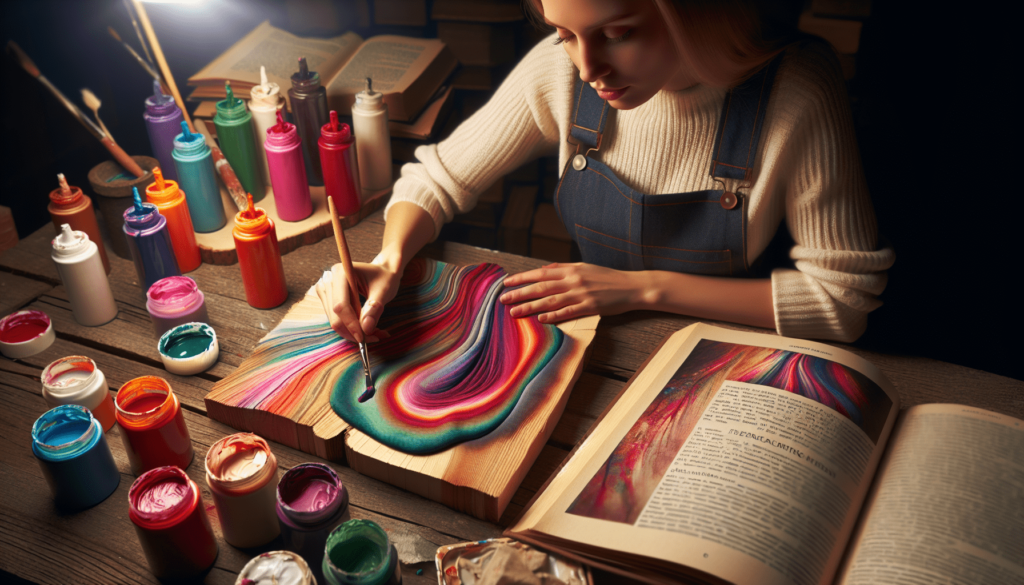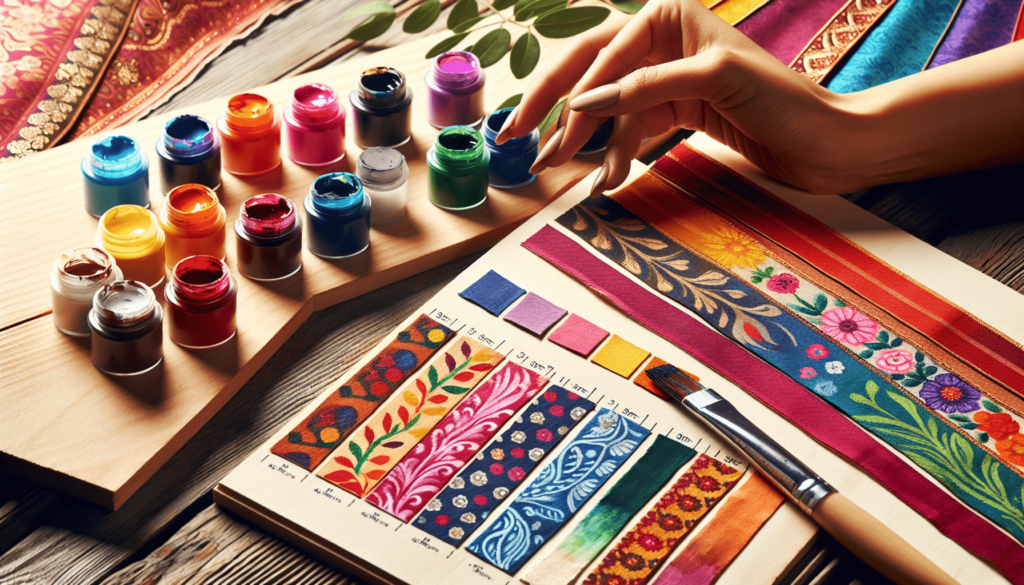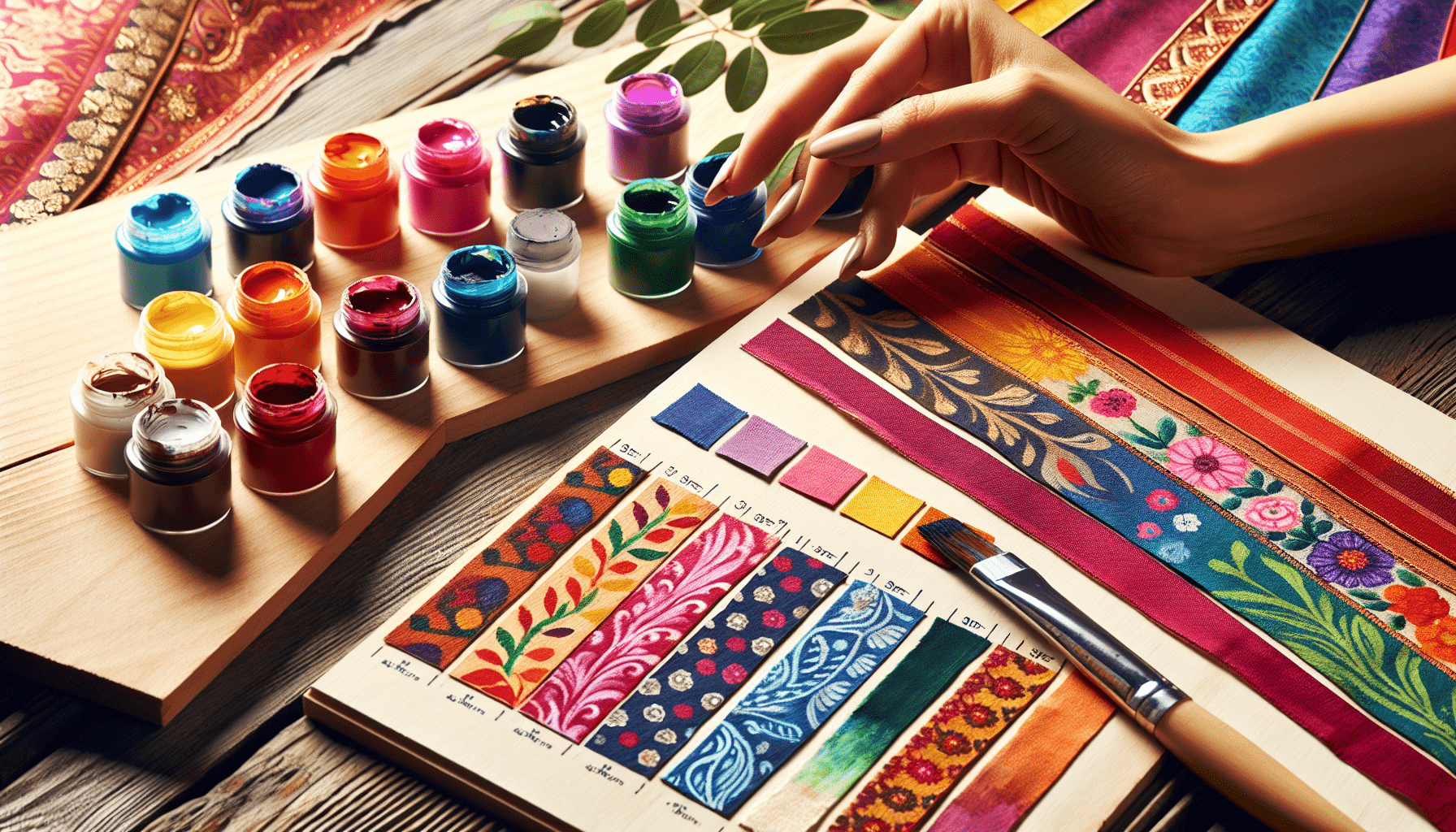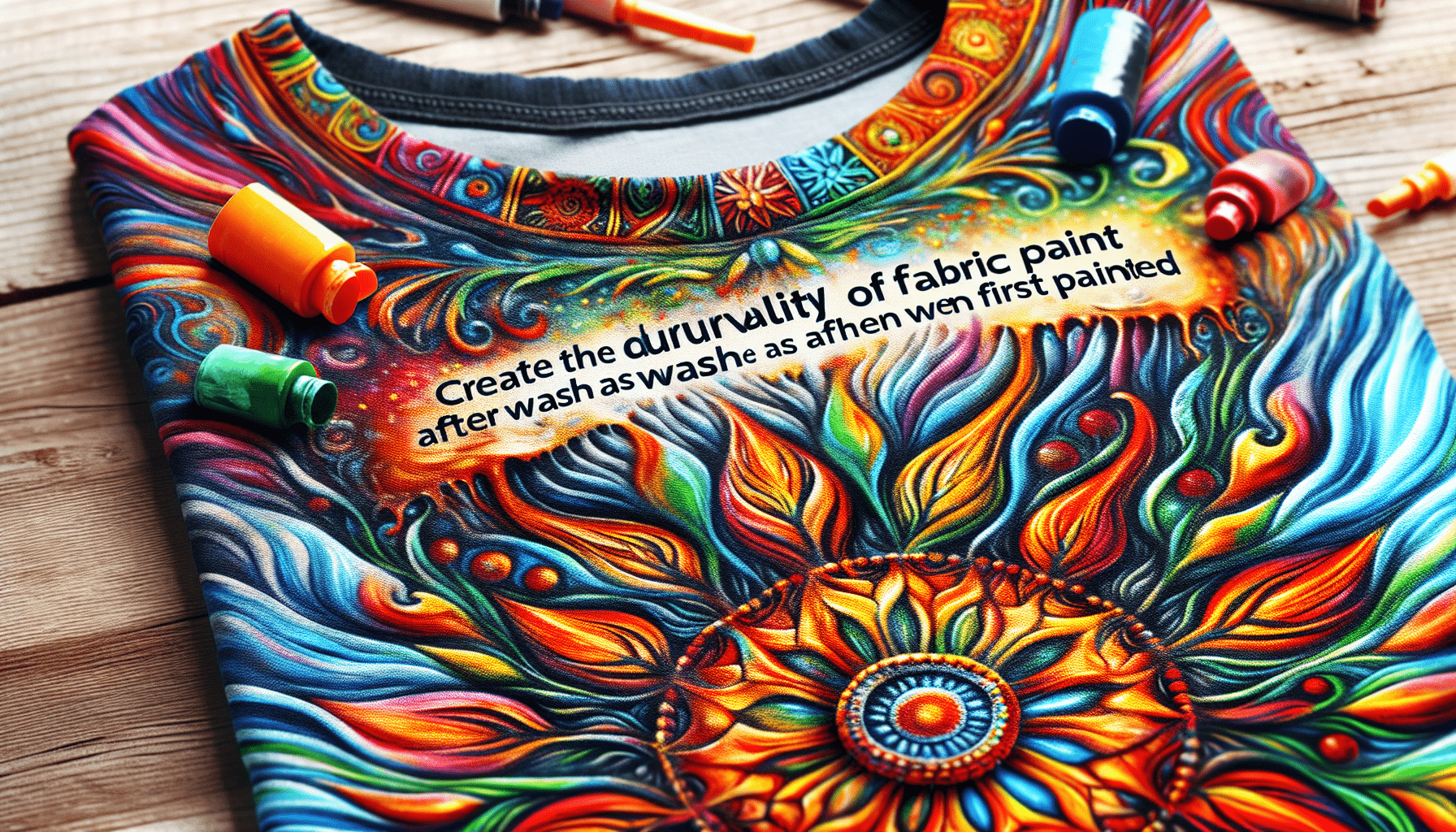In the realm of artistic expression, the mingling of unconventional mediums often results in intriguing creations. As you embark upon your own artistic journey, the question arises: can you use fabric paint on wood? This article explores the compatibility of these two seemingly disparate materials, offering insights into the potential for a striking fusion of colors and textures. By examining the properties of fabric paint and the surface qualities of wood, we aim to equip you with the knowledge necessary for enabling your artistic vision to flourish on this unexpected canvas.

Introduction
Fabric paint is a versatile medium that offers endless possibilities for creative expression. While it’s primarily used on textiles, many craft enthusiasts wonder if it can be used on wood surfaces as well. In this article, we will explore the properties of fabric paint and delve into the different types of wood surfaces commonly used in crafts. By understanding the composition of fabric paint and the characteristics of wood, we can determine the compatibility between the two and learn how to effectively use fabric paint on wood.
Understanding Fabric Paint
Fabric paint is a specially formulated type of paint that is designed to adhere to various fabrics, allowing individuals to add color and designs to clothing and other textile items. It typically consists of pigment, binder, and a carrier medium. The pigment is responsible for the color, while the binder helps to bind the pigment particles to the fabric fibers. The carrier medium, usually water or a solvent, helps to carry the paint and enables it to flow smoothly.
One of the most appealing characteristics of fabric paint is its versatility. It is available in a wide range of colors and finishes, such as matte, metallic, and glitter. Fabric paint can be applied to fabrics of different textures and thicknesses, making it suitable for a variety of projects. Whether you’re looking to create intricate designs or simply add a pop of color, fabric paint offers endless possibilities.
When it comes to fabric paint, there are various types available, each offering unique properties and benefits. Some popular types include acrylic-based fabric paint, which provides excellent coverage and durability, and fabric spray paint, which allows for effortless application and blending. Additionally, there are fabric paints specifically formulated for different techniques, such as dimensional paints for creating raised designs. By exploring the different types of fabric paint, you can choose the one best suited for your wood painting project.
Properties of Wood
Before delving into using fabric paint on wood, it’s essential to understand the properties of wood as a material. Wood is a natural material derived from trees, and it is widely used in various crafts and woodworking projects. Different types of wood possess distinct characteristics that can affect how well fabric paint adheres and interacts with the surface.
There is a wide variety of wood types commonly used in crafts, including pine, oak, maple, and birch. Each type of wood has its own unique properties, such as hardness, grain pattern, and texture. Pine, for example, is a softwood with a prominent grain pattern, while maple is a hardwood with a smoother texture. Understanding the specific properties of the wood you are working with can help determine the best approach for using fabric paint.
Another essential aspect to consider when working with wood is its porosity and texture. Some woods, like pine, have a more porous nature, while others, like maple, have a smoother texture. The porosity of the wood can affect how well the fabric paint adheres to the surface. Rough textures may make it more challenging to achieve smooth, even coverage, while smoother surfaces may allow for better adhesion.
Factors to Consider
When considering using fabric paint on wood, several factors must be taken into account to ensure successful results. It is crucial to analyze the compatibility between fabric paint and wood, review adhesion and durability considerations, and explore the impact of surface preparation on paint adherence.
Compatibility is a key factor to consider when deciding to use fabric paint on wood. While traditionally used on fabric, fabric paint can also adhere to porous surfaces like wood. However, it’s important to note that fabric paint may not bond as effectively to wood as it does to textiles. Therefore, some additional steps and precautions may be necessary to achieve optimal adhesion and durability.
Adhesion and durability are essential considerations when using fabric paint on wood. Wood surfaces can vary in their ability to receive and retain paint. Proper preparation and surface treatment can enhance the adhesion of fabric paint to wood. Additionally, considering the durability of the finished project is crucial, as wood surfaces may be subject to wear, humidity, or other environmental factors that can impact the longevity of the paint.
Surface preparation plays a vital role in ensuring the adherence of fabric paint to wood. Cleaning the wood surface of any dirt, dust, or oils is necessary to create a clean and receptive surface for the paint. Sanding the wood can help smoothen the texture, ensuring a more even application of fabric paint. Investing time in properly preparing the wood surface can greatly improve the final result.

Preparation for Using Fabric Paint on Wood
To achieve optimum results when using fabric paint on wood, proper surface preparation is crucial. Cleaning and sanding techniques are essential steps in ensuring optimal paint adherence. Additionally, priming or sealing options should be considered, along with gathering the necessary tools and materials.
Before applying fabric paint to wood, it’s important to ensure that the surface is clean and free from any dirt, dust, or grease. Start by wiping down the wood with a clean, damp cloth to remove any surface contaminants. For stubborn or greasy stains, a mild detergent or wood cleaner can be used. Once the surface is clean, allow it to dry completely before proceeding.
Sanding the wood surface is an essential step in preparing it for fabric paint. Sanding helps to smoothen the texture of the wood, creating a more even surface for the paint to adhere to. Start with a coarse-grit sandpaper, such as 80 or 100 grit, and gradually work your way up to a finer grit, such as 220 or 240, for a smoother finish. Be sure to sand in the direction of the wood grain to avoid damaging the surface.
Priming or sealing the wood surface before applying fabric paint can enhance adhesion and durability. A primer helps create a smooth and uniform surface for the paint, ensuring better coverage. It also provides a barrier between the wood and the paint, preventing any wood tannins or chemicals from bleeding through. Alternatively, a wood sealer can be used to seal the surface, providing a protective layer and helping the paint adhere better.
Gathering the necessary tools and materials is paramount for successfully using fabric paint on wood. Apart from the fabric paint itself, you will also need paintbrushes or foam brushes, sandpaper, a clean cloth, cleaning supplies, a primer or sealer, and any additional decorative elements such as stencils or stamps. Having all the necessary tools and materials prepared beforehand will ensure a smooth painting process.
Techniques for Applying Fabric Paint on Wood
Once the wood surface is properly prepared, several techniques can be employed to apply fabric paint effectively. Brushing and stippling methods, the use of stencils and stamps, as well as layering and blending techniques, can all contribute to achieving desired results. Employing these techniques along with tips for smooth and even coverage can help create stunning painted wood projects.
Brushing and stippling are common techniques used to apply fabric paint on wood. Using a paintbrush or foam brush, apply the paint in even strokes, following the wood grain. This method allows for full control over the paint application, ensuring a smooth and consistent finish. Stippling, on the other hand, involves using a dabbing motion with a brush or sponge to create a textured effect.
Stencils and stamps can be used to add intricate designs and patterns to painted wood surfaces. Place the stencil or stamp firmly against the wood surface and apply the fabric paint using a brush or sponge. Stencils can be used to create repeating patterns, while stamps allow for more detailed designs. These techniques provide a precise and professional-looking result.
Layering and blending fabric paint can add depth and dimension to painted wood. By applying multiple layers of paint, each allowed to dry before the next is added, you can achieve a richer and more vibrant color. Blending two or more colors together while they are still wet can create stunning gradients and transitions. Experimenting with layering and blending techniques can yield unique and visually appealing results.
To achieve smooth and even coverage on wood surfaces, it’s important to apply fabric paint in thin, even coats. This helps prevent a buildup of paint, which can result in an uneven and streaky finish. Allow each coat to dry before applying the next, ensuring proper drying time between layers. Taking the time and care to achieve smooth and even coverage will contribute to a professional-looking final product.
Troubleshooting and Tips
While using fabric paint on wood can yield beautiful results, it’s important to be aware of common issues that may arise and how to troubleshoot them. Paint bleed or smudging are common concerns, and preventative measures can be taken to avoid these issues. Additionally, tips for achieving vibrant and long-lasting results can help ensure the longevity of the painted wood project.
Paint bleed or smudging can occur when fabric paint spreads beyond the intended area or smears during the application process. To avoid this, it’s important to use stencils or tape to create clean, crisp edges. Secure the stencil or tape firmly to the wood surface to prevent any paint from seeping underneath. When applying fabric paint, use minimal pressure and avoid excessive brushing or dabbing, as this can cause smudging.
To achieve vibrant and long-lasting results when using fabric paint on wood, it’s essential to allow the paint to fully cure and dry. Follow the manufacturer’s instructions regarding drying times, and avoid placing any objects or applying pressure to the painted surface until it has thoroughly dried. Additionally, consider using a fabric paint that is specifically designed for durability and washability, as this can help prolong the life of the painted wood.
Sealing and Protecting the Painted Wood
To ensure the longevity and protect the painted wood surface, it is advisable to seal and protect the fabric paint. Various sealant options can be considered to preserve the paint’s vibrancy and protect it from environmental factors. Additionally, applying finishes can enhance the appearance of the wood while providing an extra layer of protection.
Sealants such as clear varnish or polyurethane can be applied to the painted wood surface to protect and preserve the fabric paint. These sealants create a protective barrier that shields the paint from moisture, stains, and UV rays, preventing color fading or deterioration. Choose a sealant that is compatible with both the fabric paint and the type of wood you are working with, and follow the manufacturer’s instructions for application.
Finishes such as wax, polish, or oil can enhance the appearance of the wood while providing an added layer of protection. These finishes can bring out the natural beauty of the wood grain and provide a smooth and polished look. Apply the chosen finish according to the manufacturer’s instructions, taking care not to disturb or damage the fabric paint. Finishes can add an extra touch of elegance to the painted wood project.
Inspiration and Ideas for Using Fabric Paint on Wood
Using fabric paint on wood opens up a world of creative possibilities. From small decorative items to larger furniture pieces, the versatility of fabric paint allows for limitless crafting ideas. Here are some examples of creative projects that utilize fabric paint on wood:
-
Personalized wooden signs: Decorate wooden signs with names, quotes, or designs using fabric paint to create customized home decor.
-
Hand-painted coasters: Paint wooden coasters with fabric paint to add a pop of color and unique designs to your table setting.
-
Painted wooden boxes: Transform plain wooden boxes into beautiful storage solutions by painting intricate patterns or illustrations with fabric paint.
-
Colorful wooden frames: Add a splash of color to photo frames by painting them with fabric paint, enhancing the appearance of cherished memories.
-
Children’s toy customization: Customize wooden toys by painting them with fabric paint, creating unique and personalized playthings for children.
-
Decorative wall art: Create stunning wall art by painting wooden panels or plaques with fabric paint and arranging them in an eye-catching display.
Exploration of decorative possibilities with fabric paint on wood is only limited by your imagination. Experiment with different colors, techniques, and patterns to create one-of-a-kind pieces that showcase your creativity.
Conclusion
In summary, while fabric paint is primarily used on textiles, it can also be successfully used on wood surfaces. By understanding the properties and characteristics of both fabric paint and wood, along with proper surface preparation and application techniques, you can create stunning painted wood projects. Remember to consider factors such as compatibility, adhesion, and durability, and take the necessary steps to ensure optimal results. With the right techniques and a touch of creativity, fabric paint can open up a world of possibilities for your woodcraft projects. Happy painting!



